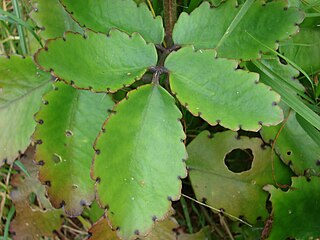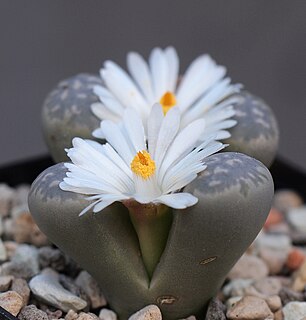Gallery
- Penwiper plant
Kalanchoe marmorata - Antique penwiper
Penwiper is a common name that can refer to a number of plant species in different nations.
In Britain and Africa it usually refers to Kalanchoe marmorata .
In New Zealand it usually refers to one of the species of alpine plants of the genus Notothlapsi - usually Notothlapsi rosulatum . [1]
The name refers to the layered, dark-blotched leaves, which appear ink-spattered like penwipers, cloth blotting papers used to clean the nibs of early ink pens. [2]

The Crassulaceae, also known as the stonecrop family or the orpine family, are a diverse family of dicotyledon flowering plants characterized by succulent leaves and a unique form of photosynthesis, known as Crassulacean acid metabolism (CAM). Flowers generally have five floral parts. Crassulaceae are usually herbaceous but there are some subshrubs, and relatively few treelike or aquatic plants. Crassulaceae are a medium size monophyletic family in the core eudicots, among the order Saxifragales, whose diversity has made infrafamilial classification very difficult. The family includes approximately 1,400 species and 34–35 genera, depending on the circumscription of the genus Sedum, and distributed over three subfamilies. Members of the Crassulaceae are found worldwide, but mostly in the Northern Hemisphere and southern Africa, typically in dry and/or cold areas where water may be scarce. although a few are aquatic.

Kalanchoe, or kal-un-KOH-ee, or kal-un-kee, also written Kalanchöe or Kalanchoë, is a genus of about 125 species of tropical, succulent flowering plants in the family Crassulaceae, mainly native to Madagascar and tropical Africa. Kalanchoe was one of the first plants to be sent into space, sent on a resupply to the Soviet Salyut 1 space station in 1971.

Aerial roots are roots above the ground. They are almost always adventitious. They are found in diverse plant species, including epiphytes such as orchids, tropical coastal swamp trees such as mangroves, the resourceful banyan trees, the warm-temperate rainforest rata and pohutukawa trees of New Zealand and vines such as Common Ivy and poison ivy.
Pachypodium habitats consist of isolated, specialized, micro–environmental niches, generally xeric, rocky, frost-free areas within parts of western Madagascar and southern Africa. Pachypodium species are often indifferent to the regional ecological, biotic zone of vegetation, a fact which explains some of Pachypodium morphology and architecture. The large scale vegetation zones are in some cases irrelevant to the micro-environments of Pachypodium, in the sense that the xeric niches may be embedded in larger mesic biomes.

Kalanchoe beharensis is a plant species in the succulent genus Kalanchoe, and the family Crassulaceae. Kalanchoe beharensis is native to Madagascar.

Bryophyllum is a group of plant species of the family Crassulaceae that is usually included as a section within the genus Kalanchoe, but has also been considered to be a separate genus. There are about forty species in the group, native to South Africa, Madagascar, and Asia. The group is notable for vegetatively growing small plantlets on phylloclade margins and tips. The plantlets drop off phyloclades and can root and grow into new plants in favorable places. The plantlets arise from mitosis of meristematic-type tissue in phyllocades.

Bryophyllum daigremontianum, commonly called mother of thousands, alligator plant, or Mexican hat plant is a succulent plant native to Madagascar. Like other members of its genus Bryophyllum, it can propagate vegetatively from plantlets that develop on its phylloclade margins. All parts of this species contain a very toxic steroid known as daigremontianin.

Kalanchoe thyrsiflora is a species of flowering plant native to Botswana, Lesotho, South Africa and Swaziland.

The western pond turtle, also known commonly as the Pacific pond turtle is a species of small to medium-sized turtle in the family Emydidae. The species is endemic to the western coast of the United States and Mexico, ranging from western Washington state to northern Baja California. It was formerly found in Canada, but in May 2002, the Canadian Species at Risk Act listed the Pacific pond turtle as being extirpated.

Isalo National Park is a National Park in the Ihorombe Region of Madagascar, in the southwestern corner of the Province of Fianarantsoa. The closest town is Ranohira, and the closest cities are Toliara and Ihosy. It is a sandstone landscape that has been dissected by wind and water erosion into rocky outcrops, plateaus, extensive plains and up to 200 m deep canyons. There are permanent rivers and streams as well as many seasonal watercourses. Elevation varies between 510 and 1268 m.

Cotyledon orbiculata, commonly known as pig's ear or round-leafed navel-wort, is a South African succulent plant belonging to the genus Cotyledon.

Hypericum scopulorum is a species of flowering plant in the family Hypericaceae. It is endemic to Socotra, an island archipelago that is part of Yemen. It is a common plant in shrubland habitat, and it is a dominant species in some areas along with Cephalocroton and another local endemic, Helichrysum rosulatum.

Kalanchoe blossfeldiana is a herbaceous and commonly cultivated house plant of the genus Kalanchoe native to Madagascar. It is known by the English common names flaming Katy, Christmas kalanchoe, florist kalanchoe and Madagascar widow's-thrill.

Kalanchoe farinacea is a species of plant in the family Crassulaceae. It is endemic to the Yemeni island of Socotra. Its natural habitat is subtropical or tropical dry shrubland at an altitude of 100-800m. While it is listed by International Union for Conservation of Nature(IUCN) as belonging to the order Rosales, Kalanchoes and other Crassulaceae are more usually placed in Saxifragales.

Kalanchoe robusta is a species of plant in the family Crassulaceae. It is endemic to the Yemeni island of Socotra. Its natural habitat is on rocky slopes and amongst limestone boulders in dwarf shrubland and low succulent shrubland at an altitude of 300–750m. While it is listed by IUCN as belonging to the order Rosales, Kalanchoes and other Crassulaceae are more usually placed in Saxifragales.

Bryophyllum pinnatum, also known as the air plant, cathedral bells, life plant, miracle leaf, and Goethe plant is a succulent plant native to Madagascar, which is a popular houseplant and has become naturalized in tropical and subtropical areas. It is distinctive for the profusion of miniature plantlets that form on the margins of its phylloclades, a trait it has in common with some other members of its genus. Many people also currently call this plant Kalanchoe pinnata.

The Conservatoire botanique national de Brest is a notable botanical garden located at 52 Allée du Bot, Brest, Finistère, in the region of Brittany, France. It is open daily without charge.

Carpesium is a genus of flowering plants in the aster family, Asteraceae. They are distributed in Europe and Asia; most occur in China and several are endemic to the country.

Kalanchoe marmorata, the penwiper, is a species of flowering plant in the family Crassulaceae, native to Central and West Africa, from Zaire to Ethiopia, Sudan and Somalia. It is an erect or decumbent succulent perennial growing to 40 cm (16 in) tall and wide, with glaucous leaves spotted with purple, and starry white, four-petalled flowers, sometimes tinged with pink, in spring. As the minimum temperature for cultivation is 12 °C (54 °F), in temperate regions it is grown under glass as a houseplant.

Lithops marmorata is a species of succulent pebble plant. It is native to Southern Africa. The specific name is derived from the Latin word marmorata meaning "marbled."
| This page is an index of articles on plant species (or higher taxonomic groups) with the same common name (vernacular name). If an internal link led you here, you may wish to edit the linking article so that it links directly to the intended article. |